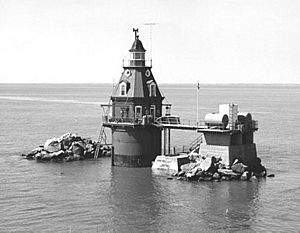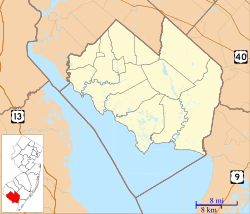Ship John Shoal Light facts for kids
 |
|
| Ship John Shoal Light (USCG) | |
|
|
|
| Location | Upper Delaware Bay near the Bombay Hook NWR |
|---|---|
| Coordinates | 39°18′19″N 75°22′36″W / 39.30528°N 75.37667°W |
| Year first constructed | 1877 |
| Year first lit | 1877 |
| Automated | 1973 |
| Foundation | Cast iron caisson |
| Construction | Cast iron with wood lining |
| Tower shape | Octagonal house with lantern on mansard roof |
| Markings / pattern | Brown with black lantern |
| Focal height | |
| Original lens | Fourth order Fresnel lens |
| Current lens | VRB-25 |
| Range | White 16 nautical miles (30 km; 18 mi) Red 12 nautical miles (22 km; 14 mi) |
| Characteristic | Flashing white 5s with red sector |
| Fog signal | Original: Bell, 3 every 45s Current: Horn, 1 every 15s |
| Racon | "O" (Oscar) |
| USCG number | 2-1640 |
The Ship John Shoal Light is a lighthouse located in the Delaware Bay on the east coast of the United States. It helps ships find their way safely through the main shipping channel. This lighthouse is special because its main structure, made of cast iron, was shown off at a big event called the Centennial Exposition in Philadelphia in 1876. It's near the Bombay Hook National Wildlife Refuge, a place where many animals live.
Contents
History of the Ship John Shoal Light
How the Shoal Got Its Name
The area where the lighthouse stands is called Ship John Shoal. It got this name from an event in 1797. A ship named the John, led by Captain Robert Folger, got stuck here. The ship was traveling from Hamburg, Germany to Philadelphia. Luckily, all the passengers and cargo were safely taken off the ship. However, the ship itself was lost. A figurehead from the ship can still be seen today. It is on display at the Gibbon House Museum in Greenwich, New Jersey. This is the town where the rescued passengers were taken.
Building the Lighthouse Foundation
After another lighthouse, the Brandywine Shoal Light, was finished in 1850, plans were made for similar lights. These new lights were to be built at Ship John Shoal and Cross Ledge. They were first designed to be "screw-pile" lighthouses. This meant their foundations would be screwed into the seabed.
However, during the building of the Cross Ledge Light in the winter of 1856, ice destroyed the whole structure. This made people rethink if screw-pile foundations were strong enough.
In the 1870s, a new type of foundation became available. These were called caisson foundations. A caisson is like a large, watertight box or cylinder. It is sunk into the ground or water to create a strong base. In 1873, the U.S. Congress gave money to build a caisson light at Ship John Shoal.
Wooden piles were driven into the seabed, and the caisson was placed in 1874. But there wasn't enough time to finish the lighthouse before winter. So, a temporary light was put up in November of that year.
Challenges and Diversions
The unfinished structure survived the winter ice. But in January, the lighthouse keepers had to leave their temporary home. They were afraid it would be knocked over by the ice. They returned in March. By then, the permanent top part of the lighthouse had been sent to the Southwest Ledge Light in Connecticut.
An identical cast iron house was then made for Ship John Shoal. But this one was sent to Philadelphia. It was displayed at the Centennial Exposition, a big exhibition. A lighthouse keeper even lived inside it and kept its light working during the show!
The lighthouse house finally reached the caisson at Ship John Shoal in the summer of 1877. While waiting, a lightship was placed next to the unfinished structure. Also, about 2,000 tons of riprap were placed around the base. Riprap is a layer of large rocks. It helps protect the lighthouse from ice damage.
Modern Updates and Preservation
In 1907, more riprap rocks were added around the light. Around the same time, a concrete platform was built on one of the rock piles. This platform held tanks that couldn't fit inside the lighthouse.
In 1973, the lighthouse was automated. This means it no longer needed people living there to operate it. Four years later, the original Fresnel lens was removed. A Fresnel lens is a special type of lens that helps make the light brighter and more focused. It was replaced with a beacon powered by solar panels. These solar panels now stand on the platform where the tanks used to be.
In June 2011, the General Services Administration offered the Ship John Shoal Light to public organizations. They offered it for free if the organizations promised to preserve it.
Images for kids



